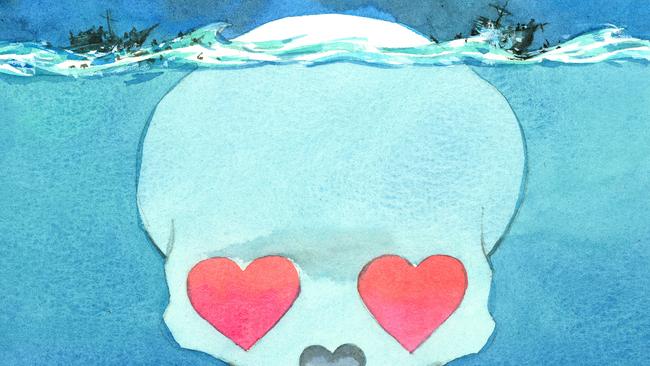
ONE of the joys of the hand-wringing game is never having to say you’re sorry.
Six years ago the editorial writers at The Age declared that a stain had been removed from the nation’s soul.
“That stain,” the newspaper continued, “was the inhumane, barbarous stance towards asylum-seekers that had presumed them guilty merely because of their existence and then condemned to indefinite detention.”
It would be too much to expect the former broadsheet to acknowledge its blunder or that the result of the policies it supported had been an unmitigated disaster. Nonetheless, there are hopeful signs that the compassion contest in which the bien pensant have been engaging since 2001 is losing its heat. A sense of reality is finally starting to permeate the debate, albeit slowly.
Nobody these days talks about “push factors”, since the relationship between the number of arrivals and the ease of gaining asylum is clear.
Let’s take a look at the scoreboard. Between 2002 and 2007, when the Pacific Solution was in place, there were 288 arrivals. From 2008 to last year, when the rules were eased, there were 51,796 arrivals.
That obvious fact, that an open-borders policy will attract many who are simply trying to game the system, is also sinking in. “Many people will dismiss this boatload of Sri Lankans as naive economic opportunists,” The Age editorialised last week, “and well they might be.”
By world standards Sri Lanka is not a particularly oppressive place. There is no reason to doubt former Labor foreign minister Bob Carr’s assessment that the theory of Tamil persecution is “an urban myth”.
The UN High Commissioner for Refugees’ latest country report on Sri Lanka notes unresolved land rights and property disputes but raises no major objections to the resettlement of people who had fled the conflict.
Nevertheless, the myth refuses to die. The return of the refugees was like sending Jews back to Nazi Germany, Malcolm Fraser unhelpfully suggested.
Human Rights Commissioner Gillian Triggs told the ABC’s 7.30 you had to go back to 1947 to find a precedent when the British turned the SS Exodus away from Palestine.
Operation Sovereign Borders? More like “Operation Slaughter”, says ABC presenter Waleed Aly who writes: “By sending asylum-seekers into the arms of the Sri Lankan navy we’re returning them to their torturers.”
Yet even Aly admits — in the last paragraph when he thinks we’ve stopped reading — that “it’s entirely possible these people are economic migrant (sic) and not refugees”.
But having invested so much in the narrative of compassion, and having argued for so long that mandatory detention and offshore processing are evil, rather than a means to deter a greater evil, it is very difficult for those who opposed the Pacific Solution to change tack.
Compassion is not an ideology; it’s a form of piety, an expression of an uncommon moral sensitivity that separates the righteous from the herd.
It is inherently judgmental since it must constantly define itself in relation to those it deems as uncompassionate. It refuses to allow that a strong border policy could be driven by an equally compassionate principle, the principle of stopping people from drowning.
Compassion requires victims, vulnerable people worthy of our benevolence, or at least our benevolent thoughts.
Plucky Tamils and desperate (always desperate) asylum-seekers more generally have played the part well through the years, and it is hard to let them go.
Hence the eagerness of the intelligentsia to believe that a “suicide wave” was sweeping Christmas Island, despite authoritative accounts to the contrary. The need for victims tempts otherwise rational people to suspend disbelief entirely.
It began on Tuesday with a press release from Ian Rintoul of the Refugee Action Coalition claiming: “Up to 10 mothers in the family camp have attempted suicide in the last two days on Christmas Island.”
That evening, Triggs put the authority of the Human Rights Commission behind the story, telling ABC viewers: “We’ve had reports that have been confirmed during the day that 10 women have attempted suicide.”
On Wednesday, The Age couldn’t resist beating up the story further: “A wave of attempted suicides has swept Christmas Island as 12 mothers tried to kill themselves in the belief their then-orphaned children would have to be settled in Australia.”
From then the story started to collapse. By the end of the day Triggs, speaking to The Guardian Australia, had reduced her claim to seven women who had “attempted suicide, threatened suicide or self-harmed”.
Even that proved to be over-egging it once the Immigration Department came out with the facts. There had been only one suicide attempt from a woman who had survived, and she wasn’t a mother.
Rintoul, the source of the original story, admitted to The Australian’s Paige Taylor: “I probably shouldn’t have said attempted suicide ... People drinking concoctions of shampoo or detergent generally don’t die.”
The Age’s Fairfax stablemate, The Canberra Times, condemned the whole thing as “a furphy”, as indeed it was.
So what was achieved by abandoning the Pacific Solution, “a spineless creed cloaked in cheap, insensitive political posturing” as The Age called it?
Australia is one of fewer than two dozen countries in the world that sets aside a portion of its annual migrant intake for humanitarian aims, and the size of the program makes it one of the most generous.
Yet the program, operated in close consultation with the UNHCR, has been effectively frozen for the past few years as officials process many thousands of applications from people arriving by boat. Meanwhile, millions who have been displaced in the Middle East, notably in Syria, and in Africa, have no hope of finding shelter in Australia unless they are able and willing to pay a large entry fee to criminal gangs indifferent to the loss of human life.
The fraudulent claim that an open borders policy is “compassionate” has been exposed. It is time we asked for our word back.


